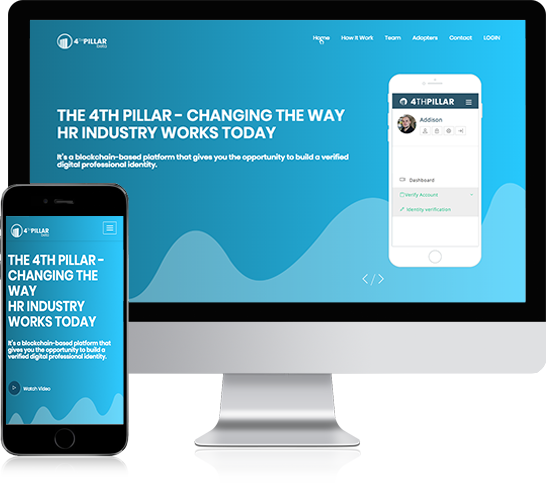The first 4th Pillar function

Most, if not all competitive businesses run, more or less, the same HR processes and most of them agree that manual effort is one of today’s biggest challenges. Teams can easily spend hundreds of hours just combing through the data stored in out of dated systems. And the data they acquire lacks validity and consistency. Even if various disparate tools that affect human capital are aligned, there is no guarantee that the data contained within them is easily accessible, shareable and visible to all relevant stakeholders. 4th Pillar will disrupt the old and out of date HR processes that have not changed for the past 70 years. We are facing three main challenges, which we will have to overcome. We already have the solutions for the problems.
CHALLENGE 1: Wallet system capable of sending multiple payments from organizations to individuals.
CHALLENGE 2: Blockchain & IPFS based postal service for sensitive registered document distribution.
CHALLENGE 3: Possibility of recruitment on the basis of verified work history.
Let me explain the first challenge and the solutions we bring to the table.
Wallet system capable of sending multiple payments from organizations to individuals
There are different financial security pillars in the world with similar shortcomings. The first issue is centralization. Our money is held by centralized organizations for a substantial fee, while we don’t know what will happen with this organization in the future. The second issue is control. We trust these same institutions that control our information and financial savings on their terms. Thirdly, all of our savings are held in FIAT currency, which is losing value over time due to unstoppable inflation. Therefore, our solution to the aforementioned issues is the 4th Pillar decentralized blockchain system, where every holder is in control over his or her own crypto savings, rewards and earnings. We are proposing a system, which will enable employers to reward or transfer FOUR tokens directly to their employees without any intermediaries (e.g. banks). The system will also give employees the possibility to save any amount of their salary, yearly bonus or other income in their own personal savings fund wallet. Thus, the aim is to build a self-managed 4th Pillar decentralized personal savings wallet, which is funded by the individual’s work organization and managed by the individual. The system will greatly save time and cost.
USER CASE 1
John, Owner of a Paper Company John has a paper production company headquartered in Germany. His company has small factories in different countries. Every month John wants to reward his employees from the headquartered company by equal treatment standards. Due to the fact that John’s factories are in different countries, cross-border payments are a problem, especially when transferring funds to non-European countries. Such transfers result in high costs and long process time. In other words, processing non EU payments is expensive and can take several days. John hears of the 4th Pillar platform, a platform designed to resolve the aforementioned issues.
Now John can reward his employees with just one click – all of his employees will receive crypto funds at the same time no matter where they are. Not to mention the significant cost savings! For each transaction via regular bank payment, John would have to pay (depending on the bank, location and the amount) either a % fee of the amount transferred or a certain fixed fee (usually from 1 to 15 EUR per transaction). The 4th Pillar platform reduces that cost to approximately 0.1 EUR per transaction no matter where in the world the transaction goes. Considering the fact that John employs over 3000 people, the 4th Pillar platform can save him thousands of euros each month.
HOW DOES IT WORK?
The 4th Pillar platform is built on the Laravel (PHP) framework. To log into the platform and create a digital wallet, a user needs a browser with a web3 provider (currently MetaMask, later our own AddOn). The log-in process is done by first clicking on the login button. MetaMask opens a popup that requires a text signature with a private key. Once the private key is entered, this signature is sent via the AJAX request to the server-side platform (Laravel) to validate the signature. Once the signature is validated, the user is logged into the platform and he/she has the option to fill in the KYC form for organizations. The digital wallet is made with Vue JS, which allows for reactivity of the application. To achieve that we use Vuex. In other words, it works by starting up the web3, a token smart contract at the Vuex store and simultaneously runs a script monitor overseeing
blockchain-related changes. Therefore, as the amount is transferred, the account is automatically updated and all changes to the network are registered. When a user wants to transfer XY token to another account, one must enter the ETH address or choose employees. The platform (system) then checks the correctness of entered data. In the event of an error, the system displays an error message. Otherwise, step 2 is displayed or the transaction confirmation step. A transaction confirmation subsequently triggers a MetaMask popup, where the user signs the transaction. Once the transaction is signed, the 4th Pillar platform will sign a transaction with a feeTaker account. The received parameters are then sent to the smart contract, which transfers the tokens from the transmitted transactions. A transaction fee is then paid by the feeTaker account, which pays the transaction to ETH, and in turn, receives a commission in the FOUR token. Once the method is successfully executed, the user will also see a link to the transaction on https://etherscan.io. We are aware of potential volatility issues and we are working on a system that will provide a TETHER based exchange of FOUR tokens during sensitive value operations.
The 4th Pillar BETA: www.the4thpillar.com
Jan Jordan Frangeš